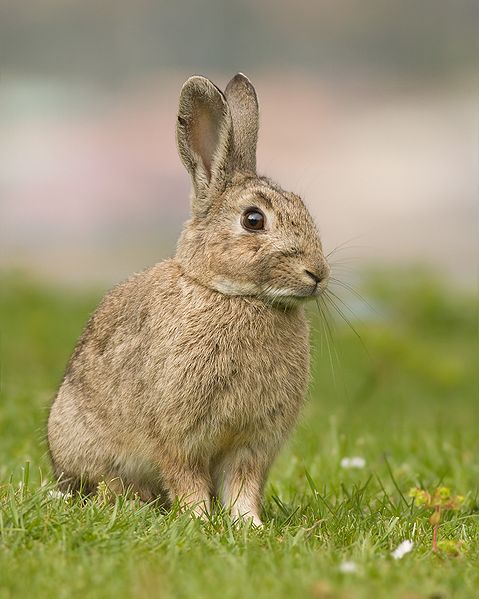Oryctolagus cuniculus
European Rabbit
Synonym(s):
Class: Mammalia
Order: Lagomorpha
Family: Leporidae

Photographer: JJ Harrison
Source: http://en.wikipedia.org/wiki/File:Oryctolagus_cuniculus_Tasmania_2.jpg
Description
The European rabbit can be identified by long floppy ears, short tail, and long jumping gait. The adult coats are typically gray-brown, but range from sandy color to black or dark gray. The underside of the rabbits are completely white with all color variations. Rabbits can be differentiated from hares by a size differences. Hares are larger than rabbits and have longer legs and ears. Male (bucks) European rabbits weigh more and have broader heads than females (does), but the overall appearance of both sexes is very similar. European rabbits are known for their ability to dig extensive tunnel systems called warrens with several entrances and exits.
Ecological Threat: European rabbits are aggressive foragers and threaten biodiversity when they become established in new non-native areas. Ironically, the European rabbit is becoming threatened in its native areas with populations decreasing rapidly warranting them to be listed on the IUCN red list. This only applies to native areas, and the European rabbit is still considered a pest in non-native areas. European rabbits are capable of becoming established in new areas because of their ability to reproduce quickly and consume a large variety of food. Populations in the billions have been documented in Australia where the European rabbit has become established and threatens many agricultural animals such as goats and sheep by removing available food sources. Other native populations that consume the same food sources as European rabbits in many countries are outcompeted and suffer drastic population losses. Many field mice are driven out of their burrows as a result of European rabbit establishment making them easy prey for foxes. Large areas of foraging causes soil erosion and loss of viable land. Native wildlife has also been effected by non-specific poisons used for control of the European rabbit.
Biology: Rabbits are well known for their ability to reproduce rapidly. A single pair of European rabbits are capable of producing 30-40 offspring each year. Female rabbits are reproductively mature after 3-4 months and can be continuously pregnant for 6-8 months. An average gestation cycle lasts for 31 days with litters of 2-12 young which are kept in a protected and secluded part of the warren where the mother feeds and protects the young individually. Although European rabbits are not known for speed or intelligence they are well known for reproductive capabilities with an extreme example in 1859 in Australia where 24 European rabbits lead to a population of over 600 million in less than a century.
History: European rabbits were first documented in Washington State in 1929, but establishment is believed to have occurred as early as 1875. The European rabbit was introduced as a control agent for weeds and other undesired vegetation and later became popular as a household pet. As a foraging generalist the European rabbit was quickly noted to feed on more than just the targeted pest plants and rapidly became established in the United States as well as all other continents in the world with the exception of Antarctica.
U.S. Habitat: European rabbits can be found in habitats that provide adequate shelter from predators such as scrub trees with areas of soft soil that allow for burrows to be dug. Habitats also are surrounded or near open areas that allow for foraging of grasses and cereals for food.
Distribution
Native Origin: Europe and North Africa
U.S. Present: European rabbits can be found throughout the United States.
Management
Historical management techniques involved the use of bounty hunters to trap European rabbits in efforts to control the growing populations. Other more recent bio-control involves the use of a virus specific to the European rabbit that was discovered in the Brazilian rabbit. This virus was highly effective in Australia, but 0.02% of the population survived and developed a resistance. Current management techniques are being developed involving a protein that prevents birth prior to fertilization rather than focusing on killing European rabbits. Within the U.S. a vigorous attempt to control European rabbit populations in San Juan park of Washington is in the works. The beautiful landscape has been stripped bare to the point of a moon-scape according to park officials.
References
Alien Species in Hawaii: European Rabbit - Status of Orctolagus cuniculus spp. cuniculus (Leporidae) in the main Hawaiian Islands as of 05/98.
Elspeth M. Veale. 1957. The rabbit in England. Agricultural History Review. 5(2).
Internet Sources
http://www.nationalparkstraveler.com/
http://www.bbc.co.uk/nature/life/European_Rabbit
 Texas Invasive Species Institute
Texas Invasive Species Institute